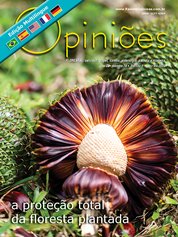Everton Pires Soliman
Pesquisador Senior de Proteção Florestal da Suzano
OpCP70
O que é uma praga?
O conceito praga, embora conote relevância biológica, é um termo financeiro, pois se trata de um inseto que, ocorrendo no plantio, pode provocar perdas produtivas. Se não provocasse prejuízos econômicos, seria somente um inseto na floresta. Em cenários de guerra, quando temos um inimigo (nesse caso, as pragas) e um impasse (as pragas necessitam de comida, e, nós, da produção), é preciso desenvolver estratégias de convivência e, em casos severos, de contenção.
Os insetos-pragas geralmente são adaptados, evoluídos, numerosos e se dispersam com facilidade, e, para conviver com eles, foi criado pela comunidade científica o MIP – Manejo Integrado de Pragas –, que consiste num pacote de ações de manejo das pragas, tendo como base resultados de pesquisas cientificas. O MIP também surgiu na agricultura visando auxiliar na solução de problemas no manejo convencional das pragas, entre eles a resistência de insetos a inseticidas, ressurgência de pragas e renovação da estratégia para o controle de pragas.
Dessa forma, o desafio é trazer o MIP da teoria acadêmica para a prática em mais de 1,5 milhão de hectares com eucalipto, como para nós da Suzano. O conceito acadêmico foi resumido e focado em aspectos práticos da rotina de produção de madeira, visando termos um sistema de decisão para uso de táticas de controle, isoladamente ou associadas harmoniosamente, numa estratégia de manejo baseada em análises de custo-benefício que levam em conta o interesse e/ou impacto econômico, social e ambiental.
As ações do MIP se baseiam em três princípios: a detecção, o monitoramento e o controle das pragas. Na detecção, é necessário conhecer o inseto-praga que se deseja encontrar, exigindo a capacitação das equipes de campo. Estudos de flutuação populacional da praga-alvo e seus inimigos naturais possibilitam identificar épocas de ocorrência e sua interação com fatores ambientais e, assim, facilita para que a detecção seja ágil, fator primordial para o sucesso do MIP.
O segundo princípio é o monitoramento, que consiste na quantificação da incidência da praga (densidade populacional do inseto e distribuição espacial) e da severidade do seu ataque (dano na planta), o qual varia para cada inseto (ciclo, padrão de ataque, dispersão etc.). No monitoramento, também é avaliado o controle biológico natural da praga que ocorre por inimigos naturais que ocorrem nos plantios e reduzem a população da praga.
As informações do monitoramento auxiliam no último pilar do MIP, a tomada de decisão, quando as táticas de controle disponíveis são utilizadas de maneira sinérgica para controle da praga, seja numa estratégia preventiva ou curativa.
Atualmente, temos diversas estratégias de controle; as mais utilizadas no setor florestal são: genético (clones resistentes ou tolerantes), cultural (táticas culturais que reduzem a pressão da praga), biológico (utilização de microrganismos ou outros insetos que levam a praga à morte) e químico (inseticidas).
Infelizmente, o MIP não é um produto capaz de ser adquirido, pois ele é desenvolvido de forma personalizada para cada realidade (idade da cultura, região, tipo de dano, valor financeiro do produto, relevo, disponibilidade de inseticidas, tempo de ação, etc). Para cada espécie de praga, técnicas de detecção, monitoramento e controle são desenvolvidos, e o conjunto dessas recomendações se denomina MIP.
Por exemplo, as lagartas desfolhadoras do eucalipto, como a Thyrinteina arnobia: a detecção da praga pode ocorrer em vistorias nos plantios, na época de ocorrência, concentrada em regiões mais endêmicas e em clones sabidamente mais atrativos que outros (para essa praga, não há clone comercial resistente). Após detectar, o monitoramento pode ser realizado com armadilha luminosa (atrativo para a fase adulta das mariposas), avaliação direta dos ramos (utilizado para a fase larval das lagartas e pupa) e avaliação dos excrementos (amostragem correlacionada com a fase de larva das lagartas).
Mediante as informações do monitoramento, o controle poderá ser via: liberação de poucos parasitoides de pupas ou predadores (infestação baixa); liberação de muitos parasitoides de pupas (infestação média); e/ou pulverização de inseticidas biológicos/fisiológicos e coleta em massa de adultos (infestação elevada).
Para uma outra espécie de lagarta florestal, a Sarsina violacens, embora provoque os mesmos danos da Thyrinteina arnobia, o MIP é ajustado na fase de monitoramento devido ao comportamento das lagartas em permanecer no tronco durante o dia. Nesse caso, ao invés de fazer uma avaliação direta nos ramos, se quantifica a praga no caule. Essa é uma de tantas outras evidências de que o MIP deve ser personalizado, respeitando as peculiaridades e especificidades de cada desafio a ser manejado.
O MIP de pragas florestais não pode ser desenvolvido no momento de surto populacional da praga, sua concepção deve estar aliada à estratégia de produção como uma técnica auxiliar na prevenção de potenciais perdas produtivas. Se realizado de forma precisa e eficaz, garante a sustentabilidade da produção e otimização no uso dos recursos disponíveis para manejo das pragas. Portanto, trata-se de uma ferramenta extremamente científica, mas que se encaixa bem numa rotina operacional dos produtores de madeira.




